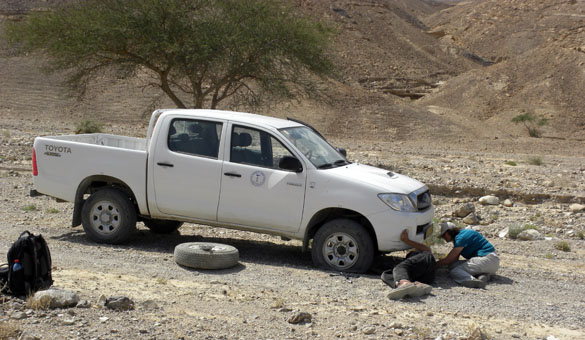Guest blogger Jon Theisen
Beginning May 17th and running until June 10th, the College of Wooster Tree Ring Lab has been partnering with and funded by The Center for Entrepreneurship in an effort to demonstrate the viability of dendrochronological dating as a business opportunity. The professor in charge of the Tree Ring Lab, Greg Wiles, and his employees, Jon Theisen and Anna Mudd, have spent the last four weeks collecting and dating samples gathered from the towns of Worthington and Somerset, Ohio. The first week of the project consisted of traveling to the towns of Worthington and Somerset, which are approximately two hours south of Wooster.
Greg Wiles and Jon Theisen consulting with Somerset Mayor Tom Johnson in the Ridenour Barn, one of the many structures sampled by the Wooster Tree Ring Lab
On Tuesday, May 17th, members of the Tree Ring Lab traveled to Worthington, Ohio, in order to sample two structures for the Worthington Historical Society. The first structure was the Old Rectory, which the Tree Ring Lab successfully dated to 1846. The Old Rectory was built to house the reverends of St. John’s Episcopal Church.
In the afternoon, members of the Tree Ring Lab went to the Orange Johnson House, just a quick drive from the Old Rectory, in order to gather tree ring samples. The Orange Johnson House was successfully dated to 1811 for the original structure.
The next day, researchers traveled to Somerset, Ohio, to meet with the Mayor, Tom Johnson. Mayor Johnson had a number of structures that he wanted dated, so the Tree Ring Lab got to work.
The front of the Miller Tavern in Somerset, Ohio. Although the exterior of the building has been renovated, the interior beams of the building are still original.
The first building the team sampled in Somerset, Ohio, was the Miller Tavern. The image above is of team member Jon Theisen using a hand auger to retrieve a wooden core sample from a wall beam in Miller Tavern. The Miller Tavern was successfully calender dated to 1808.
The team spent Thursday, May 19th in the Tree Ring Lab becoming familiar with the equipment and computer programs they would use to date the cores retrieved from the structures we sampled. Below is an image of what the retrieved cores look like after they have been sanded and mounted.

The retrieved cores are glued into wooden mounts, and then sanded with a belt sander and high grit sandpaper until they are very smooth and the individual rings can be seen under the microscope. The cores are counted and the total number of years represented by individual rings is written on the side of the mount. After the initial count is completed, the cores are placed on the Acu-Rite measuring system, and by using a computer program called Measure J2X, the width of the individual tree rings is measured to the nearest 0.001mm. These measurements are saved to a computer file where they can then be edited. A computer program called COFECHA is then used to compare the ring width data of cores taken from a single structure against each other to create a “floating” chronology where the cores are relatively dated against one another.
An example of how cores can be dated relative to each other in order to develop a “floating” chronology
Once a “floating” chronology has been developed for a structure, the ring width measurements are compared against a calendar dated master series of measurements that have been previously dated. By comparing the “floating” chronology against the master series, a calendar date can be assigned to the structure.
After a day in the lab, the team was ready to get back out in the field and continue gathering samples. Friday, May 20th saw members of the Tree Ring Lab return to Somerset, Ohio, to gather samples from more structures off of Mayor Tom Johnson’s list. In the morning the team stopped at the Linnabary House, pictured below, to take a sample. According to the owners, the house was originally used as a church. The beam was successfully dated to 1823.
In the afternoon, the team collected samples from two structures. The first building was the historic library of Somerset, which was still in use today. The team went down to the basement of the library, pictured below, and gathered samples from the joists supporting the floor. The library was successfully dated to 1818.
After the library, the team traveled into the country and visited the Johnson House, pictured below. While the building had been damaged by recent storms that downed trees, Tom Johnson is hoping that a date for when the structure was built will help secure funds for rehabilitating the structure. The Johnson House was calendar dated to 1817.

After the first week in the field, the team spent the following three weeks in the Tree Ring Lab sanding, counting, and dating cores. During this time, Jon Theisen and Anna Mudd created seven reports detailing the findings for each structure, a poster, and a blog post. The reports consist of the name of the structure, a description of the dating techniques used, the calendar date of the samples, and a graph showing how well the measured samples correlate with the master series they were dated against.
These four weeks have shown members of the Tree Ring Lab that there is a great demand for dendrochronological dating. Dr. Wiles has continued to receive requests for the Tree Ring Lab to visit sites across Ohio in order to gather samples and provide dates for historic structures.












































